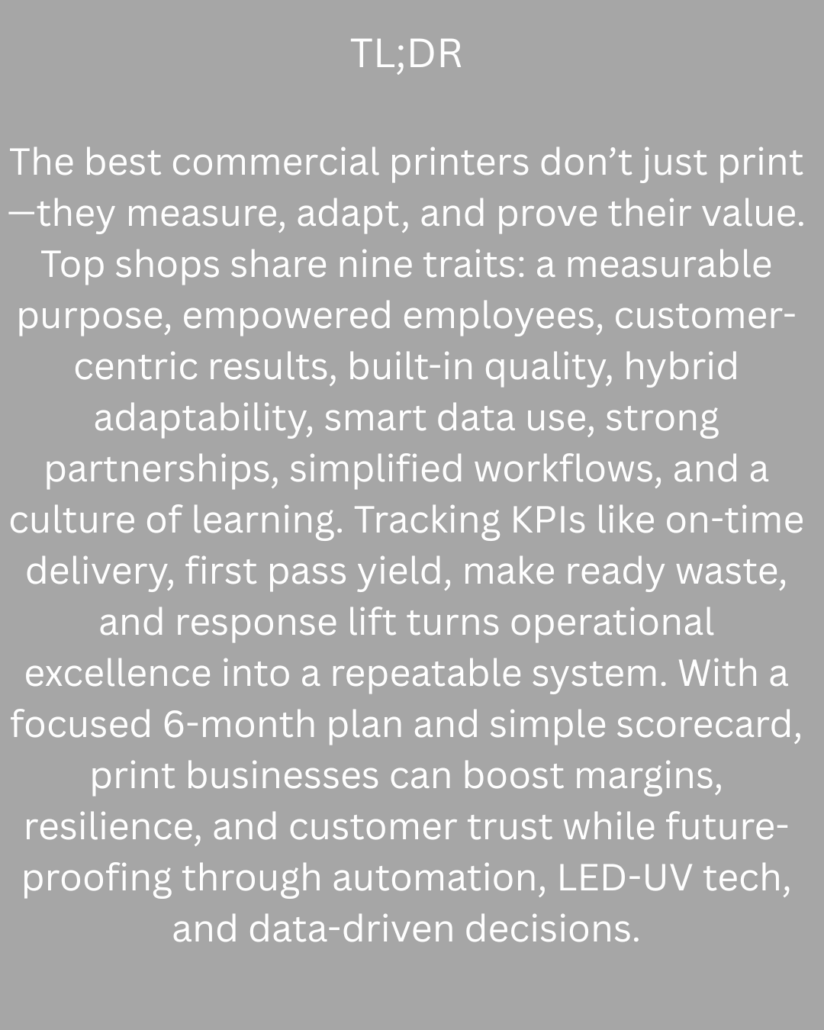The 9 Traits of High-Performing Commercial Printers (and the KPIs that prove it)
The difference between good shops and great ones
Walk into any struggling print shop and you’ll hear the same story: “We do great work, but customers only care about price.” Walk into a thriving one and you’ll hear something different: “We track what matters, and our customers pay for the results we deliver.”
The difference isn’t luck. It’s not location or equipment age either. The best commercial printers—whether they’re running packaging lines, direct mail campaigns, or commercial jobs—operate on nine core traits. More importantly, they measure every single one.
This isn’t about collecting data for data’s sake. It’s about turning excellence from a feeling into a system. When you can measure it, you can improve it. When you can improve it, you can sell it.
The commercial print market remains huge, but the money is moving. Winners are using AI-assisted operations, hybrid equipment platforms, and most critically, they’re proving measurable outcomes for their customers.
This guide breaks down each trait in plain language and gives you the exact KPIs to track your progress

1) Purpose that sells, not just inspires
Every print shop has a mission statement somewhere. Most of them sound nice and mean nothing.
The difference? Top performers turn purpose into promises they can prove. Instead of saying “we care about sustainability,” they show you their LED-UV curing percentage on every quote. Instead of claiming “we’re reliable,” they guarantee 95% on-time delivery and track it publicly.
Here’s what measurable purpose looks like in action: You print the sustainability and security certifications directly on your quotes. You include your on-time delivery percentage in quarterly business reviews. You choose FSC-certified or recycled stocks and tell customers exactly how much waste you prevented.
When your purpose becomes a tracked promise, something shifts. You stop competing purely on price because you’re selling something else: certainty, compliance, and values your customers can verify.
Track these: On-time delivery rate (target 95% or higher), percentage of jobs using LED-UV or low-VOC processes, and certifications earned.
2) Employee experience equals uptime
Your best press operator just saved a job that was printing off-color. How? Because she wasn’t stressed, undertrained, or working with tools that fight her every step.
Happy, skilled operators keep presses running. But happiness isn’t about ping-pong tables—it’s about removing friction from their workday. AI-assisted color control takes the guesswork out of makeready. Automated setup reduces cognitive load during long shifts. Cross-training means your team can flex when someone’s out sick instead of machines sitting dark.
The shops with the lowest turnover also have the clearest growth paths. People stay when they see a future. They leave when they feel stuck running the same press with the same problems year after year.
Less stress and more skill show up as fewer errors, faster changeovers, and machines that actually run. That shows up in your margin.
Track these: Makeready waste (sheets per job), percentage of staff cross-trained on multiple functions, and unplanned downtime (hours per press per month).

3) Customer-centricity you can quantify
“We put customers first” is table stakes. Everyone says it. The question is: can you prove it?
The best shops measure outcomes their customers actually care about. When you run variable data printing for a direct mail campaign, you don’t just deliver boxes of mail—you deliver response rates. When you add QR codes or personalized URLs to those mailers, you track exactly how many people visited and converted. When your customer asks if print or email works better, you show them the data.
This is what separates vendors from partners. Vendors deliver printed pieces. Partners deliver response lift, attribution reports, and ROI calculations. One competes on price. The other expands accounts.
Real customer-centricity means connecting print to outcomes. Every phygital bridge you add—QR codes, NFC tags, personalized landing pages—creates a measurement point. Use it.
Track these: Campaign response rates (direct mail versus email), QR code or pURL visit-to-order conversion, and complaint rate (keep it under 1%).
4) Quality as a cultural cornerstone
Quality isn’t the QC check at the end of the line. It’s the press operator who spots a hickey three sheets into the run. It’s the scheduler who builds in time for proper makeready instead of rushing every job. It’s the maintenance tech who replaces rollers before they start causing problems.
The best shops build quality into every second of production. Inline inspection systems catch defects while they’re happening, not after you’ve printed 5,000 bad sheets. Predictive maintenance prevents breakdowns before they kill your Thursday. LED-UV curing stabilizes color and opens up substrate options you couldn’t run before.
Make first pass yield your north star metric. When everyone in the building knows that number and sees it daily, everyone understands the mission. Quality becomes a reflex, not a department.
Track these: First pass yield percentage, average color Delta E (aim for under 2), and repeat defect trends over time.
5) Adaptability through hybrid platforms
Last month you ran 50,000 identical brochures. This month you’re running 5,000 direct mailers, each one personalized. Next month it’s 500 different versions of a packaging label.
If your shop can only do one thing well, you’re leaving money on the table. Hybrid platforms give you options. Offset handles your long runs at low cost. Digital takes care of personalized short runs. Flexo serves your packaging and label customers who need fast versioning. Smart scheduling software routes each job to the right machine at the right time.
Adaptability isn’t about owning every type of press. It’s about having a system that protects your margin when order profiles shift. The shops that survived the last fifteen years didn’t just buy digital presses—they built workflows that could handle both digital and offset intelligently.
Track these: Percentage of jobs using hybrid workflows, average changeovers per day, and short-run turnaround time in hours.

6) Data-driven decisions (without drowning in data)
Dashboards don’t automatically make you smarter. Half the shops with fancy MIS systems still make decisions based on gut feel because their dashboards answer questions nobody’s asking.
Data-driven decision making starts with real business questions: How long does it take to get a job from order to press? How many times do we touch each job? How fast do we quote, and how often do we win? Connect your MIS, web-to-print system, CRM, press sensors, and mailing data to answer those questions—not to create pretty charts.
The shops doing this well have simple operating rhythms: daily huddles around a live production board, weekly reviews of sales pipeline and costs, monthly deep dives on quality trends. The data serves the conversation, not the other way around.
When you cut job onboarding time and reduce touches, customers notice. When you quote faster, you win more work. That’s what data is for.
Track these: Time from order to press, touches per job, and quote-to-win cycle time.
7) Ecosystem intelligence and collaboration
No print shop wins alone anymore. The question is whether you’re a commodity supplier or the hub your customers can’t work without.
Top performers build ecosystems. They partner with data specialists who clean lists and ensure compliance. They work with postal optimization firms who cut delivery time and postage costs. They connect with finishing and kitting partners who accelerate in-hands delivery. They build alliances with agencies to package strategy and analytics with print.
Then they sell outcomes instead of impressions: proven attribution, faster speed-to-market, guaranteed compliance, measured response lift. When you orchestrate the ecosystem, you capture more of the value.
Your customers don’t want to manage six vendors. They want one partner who makes it work.
Track these: Percentage of revenue flowing through partner ecosystem and attach rate for analytics or postal optimization services.
8) Operational excellence through ruthless simplification
Complexity kills margin silently. Every manual handoff, every walk across the plant floor, every rekeying of data, every workaround for a broken process—it all adds cost you can’t bill for.
The best shops simplify obsessively. Modern digital front ends push variable data jobs through 2× to 50× faster than old workflows. Lights-out automation removes manual touches from finishing. Standardized work makes changeovers predictable instead of an art project every time.
This isn’t about working harder. It’s about removing friction. Every click you eliminate, every handoff you automate, every exception you standardize—that’s money returning to your margin.
Track these: Manual touches per job, SLA attainment rate, and operator-to-throughput ratio.
9) Learning organization mindset
Great plants treat every week like a chance to get better. They run weekly operations stand-ups focused on makeready performance, on-time percentage, and waste. They hold quarterly kaizen events from prepress to finishing. They keep a public scoreboard so everyone sees the wins and the gaps. They maintain a living AI roadmap covering predictive maintenance, intelligent scheduling, and dynamic pricing.
The critical difference? They treat misses as information instead of failures. When a job runs late, they ask why and fix the system. When waste spikes, they trace it back and solve it. Curiosity compounds over time.
The shops that keep learning keep winning. The ones that stop learning start declining—even if they don’t notice right away.
Track these: Waste percentage trends over time, schedule stability week-over-week, and AI use cases deployed per quarter.

Where the money is moving
Three trends are reshaping where profit lives in commercial print.
Digital, short-run, and personalization segments are growing two to four times faster than the overall market. The shops capturing this growth aren’t just buying digital presses—they’re building workflows that make personalization efficient and profitable.
Offset isn’t dying; it’s evolving. When you pair offset with automation and LED-UV technology, you get faster curing, lower VOC emissions, and wider substrate compatibility. Long runs still matter, but only if you can run them profitably.
Direct mail keeps outperforming digital-only outreach on response rates. Election cycles make it even hotter. But the mail that works isn’t generic anymore—it’s personalized, tracked, and connected to digital experiences.
The pattern is clear: value flows to speed, accuracy, and proof of impact.
Your 6-month execution plan
Don’t boil the ocean. Pick battles you can win this year.
Months 1-2 (now): Deploy predictive maintenance on your two most critical presses. Target a 15% reduction in unplanned downtime. Publish your three core brand promises—on-time delivery percentage, sustainability commitment, and security standards—on every quote and your website.
Months 3-4: Launch a web-to-print storefront for standard products with transparent pricing. Target 500 online orders per month within 90 days. Set up QR code or pURL tracking for two anchor clients. Baseline their response rates versus email and report the lift.
Months 5-6: Run an LED-UV or waterless offset pilot. Convert your top-selling SKUs to recycled or FSC-certified stocks where appropriate. Deploy an automated DFE and VDP workflow to eliminate manual touches in your mail and personalization jobs.
Months 7-8: Launch a hybrid run strategy with clear pricing rules. Define when jobs run on offset, when they run digital, and how you price each to protect margin on short runs.
Track progress monthly. Adjust based on what’s working. Don’t add new initiatives until you’ve made real progress on these.
Risk radar: plan for what’s coming
Three risks deserve attention now, not later.
Postage and materials inflation will continue. Protect yourself by quoting with postal optimization built in and adding indexed materials clauses to contracts. Help customers save money through intelligent mailing strategies.
Labor gaps aren’t going away. Automate first, then upskill your best people on digital front ends, variable data workflows, and data compliance. Make your shop a place where people learn valuable skills.
Cyber and privacy threats grow as you digitize. If you’re running web-to-print and handling customer data, lock down multi-factor authentication, encryption, and relevant certifications now. Trust is an asset you can’t rebuild quickly once it’s lost.
Your simple scorecard (print it and post it)
Track six categories, each with 1-3 metrics:
Speed: Order-to-press time and changeovers per day
Quality: First pass yield, color Delta E, and repeat defects
Reliability: On-time delivery percentage and unplanned downtime
Efficiency: Makeready sheets per job and touches per job
Customer impact: Response lift versus other channels and complaint rate
Growth: Attach rate for analytics or postal optimization and percentage of jobs using hybrid workflows
When these numbers move in the right direction, so do revenue and profit. Keep it visible. Review it weekly. Act on what it tells you.

Put excellence on the scoreboard
Excellence isn’t an award you win at an industry dinner. It’s the dashboard you review every Monday morning. It’s the cadence of improvement your team lives every week. It’s the contracts you sign with customers who pay for measured outcomes instead of negotiating on price.
Start with one promise you can measure. On-time delivery is a good place. Share the score publicly—with your team and your customers. Improve it together. Add a second metric next quarter.
The shops that win don’t collect trophies. They collect on-time delivery percentages above 95%, first pass yields that keep climbing, makeready waste that keeps dropping, and response lifts that prove print still works.
Make excellence visible. Make it measurable. Make it your system, not your slogan.
People Also Ask (FAQ)
Q1: What KPIs matter most for a print shop?
Track on-time delivery rate, first pass yield, makeready waste per job, unplanned downtime, touches per job, and campaign response lift. These show your speed, quality, efficiency, and customer impact in numbers you can act on.
Q2: How does LED-UV printing help my business?
LED-UV cures ink instantly, cuts VOC emissions, improves color stability, and lets you print on stocks you couldn’t use before. Jobs finish faster with less waste and environmental impact.
Q3: What does “hybrid printing” mean?
Hybrid means using offset or flexo for long runs and digital for short or personalized runs. You route each job to whichever process is most efficient, protecting margin across different order types.
Q4: How can I prove direct mail actually works?
Add QR codes, personalized URLs, or NFC tags to your mail pieces. Track visits and conversions, then compare results to email campaigns. Report the response lift to show exactly what print delivered.
Q5: What’s one improvement I can make this quarter?
Build a simple dashboard showing on-time delivery, first pass yield, and makeready waste. Review it weekly with your team. Pick one bottleneck and fix it. Repeat next quarter.




